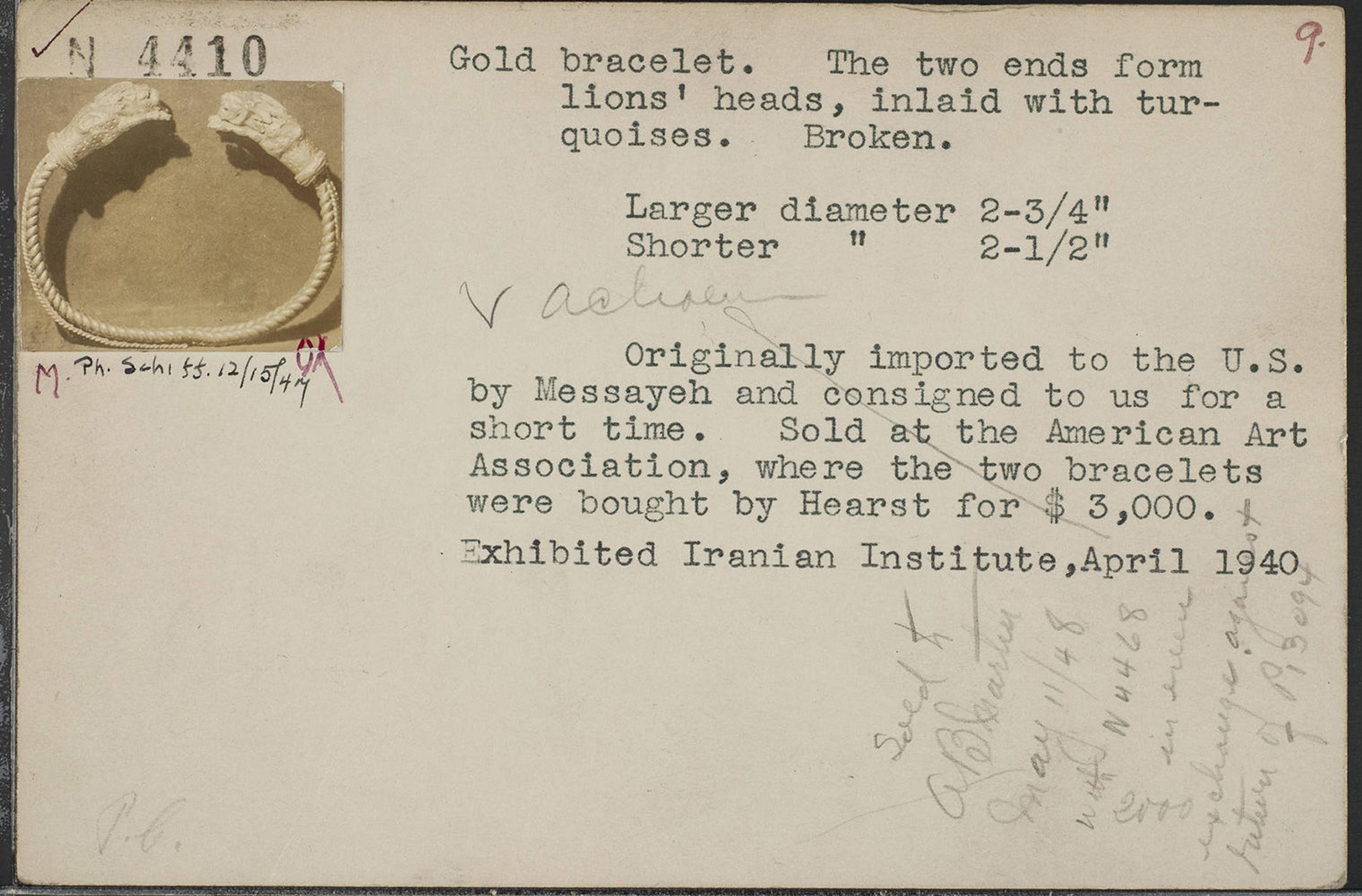To celebrate International Provenance Research Day (April 13th), I chose to tell the modern story of two gold bracelets with terminals in form of lion foreparts in The Met’s collection. Until recently the only ownership history known for each object was their respective donors. Now my provenance research has revealed a much fuller picture. When one of the bracelets was acquired by the Department of Ancient Near Eastern Art in 1971 as part of the bequest of Walter C. Baker (1893-1971), a note was added to its catalogue card: “see also our 48.154.7 for a very similar bracelet but with mane inlay intact”. While researching the Brummer Gallery Records, I was able to confirm a close connection between the two bracelets because the Brummer stock cards showed that they in fact share the same provenance.
The bracelets were imported in 1918 to the United States by Razouk David Messayeh (1878-1957), a Bagdad dealer who along with his brothers was active in the Mesopotamian antiquities trade. In a letter to Professor A.T. Clay, Curator of the Yale Babylonian Collection, New Haven, Messayeh announced the arrival of a shipment of antiquities “direct from Babylonia” and “including a unique and remarkable gold bracelet set with precious stones”. He presented the pair in a report entitled “Gold Bracelets from Nippur, in Southern Babylonia” ending with “The bracelets are so wonderfully well preserved that a queen could not desire the wearing of a more individual, as rare and beautifying ornament.”
In May 1918, Messayeh offered the bracelets for sale to The Met but the sale was declined. It appears that Messayeh, although active in New York since 1913, never succeeded in selling antiquities from West Asia to The Met. However, 15 objects previously in the possession of the Messayeh brothers entered the Museum through other means, notably the bequest of W. Gedney Beatty (1869-1941). In fact, the bronze head (47.100.80) purchased in 1947 from the estate of Joseph Brummer, was probably part of the same shipment to Messayeh as the bracelets in 1918.

Head of a ruler, Rogers Fund, 1947 (47.100.80)
Finally, Messayeh included the pair at the sale of the American Art Association, New York, held on March 8 and 9, 1922, as lot no. 96, in a “Group of very important Babylonian objects”. The gold bracelets were attributed to Warka, another famous city in southern Iraq, in the lot entry but this provenience was contested by Messayeh after the sale. William Randolph Hearst acquired the bracelets through Joseph Willicombe at the sale, and they remained in his possession until 1939 when Joseph Brummer purchased the pair from Parish-Watson & Co., New York, and recorded them in his New York stock as N4410 and N4411.

Object inventory card N4410 (recto) Donated to The Metropolitan Museum in 1980, through Ella Baché Brummer, wife of Ernest Brummer. Transferred to The Cloisters Archives in 1993.

Object inventory card N4411 (recto) Donated to The Metropolitan Museum in 1980, through Ella Baché Brummer, wife of Ernest Brummer. Transferred to The Cloisters Archives in 1993.
In 1942, N4411 was purchased by Walter C. Baker from Brummer and acquired by the Museum in 1971, as mentioned above, as part of the bequest of Walter C. Baker. FN4410 was purchased in 1948 by Alastair Bradley Martin, The Guennol Collection, who gave it to the Museum the same year. According to Dietrich von Bothmer, former head of the Department of Greek and Roman Art at The Met, the bracelet gifted by Baker is today in two pieces because it was used as a watchband. The object was cut in half: a section is missing and a silver sleeve added to one end is still in place. These modifications happened after 1922 based on Brummer’s photograph so Walter C. Baker most certainly ordered them.
Many sources are consulted for provenance research: curatorial, registrar, and institutional archival files as well as dealers’ papers. The ownership history of these two bracelets, reunited at The Met after 30 years apart, was reconstructed thanks to a variety of documentation. The Museum’s Central Catalogue holds important resources, notably in this case for objects offered for sale but declined. The Brummer Gallery Records, available through Watson's Digital Collections since 2013, are an invaluable source of information. Finally, I am very grateful to Agnete Lassen, Associate Curator of the Yale Babylonian Collection, New Haven, for facilitating this research digitally at a time visits to the Yale archives were not possible due to Covid 19.
